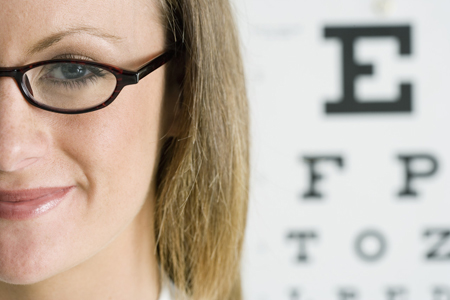Services
Glaucoma Basics
Glaucoma is a group of disorders in which the main risk factor is high fluid pressure within the eye. All glaucoma disorders are characterized by vision loss, caused by damage to the optic nerve. The optic nerve provides the pathway from the eyeball to the brain. If a doctor discovers it early and the patient follows directions carefully, the damaging effects of glaucoma can be addressed.

In a normally functioning eye, fluid is being formed and drained constantly. However, when an eye's drainage canals do not work well, the fluid cannot get out. The extra fluid raises the pressure inside the eye. The increased pressure can destroy sensitive nerve fibers on the back wall of the eye. Each time a nerve fiber is lost, the eye loses some ability to see. Usually, the glaucoma patient loses peripheral (side) vision first; eventually central vision can be lost. When vision is lost from glaucoma, it is irreversible and cannot be restored.
Diagnosis and Evaluation
Clinical Evaluation During your Visit
Your visit to the Dr. Janet Betchkal Glaucoma Service will include a very specialized exam as well as specific diagnostic tests, which aid the physician in providing a comprehensive evaluation of your condition and in answering any questions you may have.
The initial evaluation will cover your medical history, ocular history and family history. Examinations and diagnostic tests can include slit-lamp biomicroscopy, gonioscopy, optic nerve head imaging, tonometry (pressure), threshold visual field (also known as perimetry), non-mydriatic fundus photography, and nerve fiber analysis.
What to expect from your first visit
As a result, please be prepared to be here for 2 to 3 hours on your first appointment. Almost every new patient will have his or her pupils dilated in order to do a complete ophthalmic evaluation. Dilation takes 30 to 45 minutes, but the effects can last an average of 4 to 6 hours. In some cases, effects persist up to 24 hours. Blurry vision is usually a side effect, and it is strongly suggested that patients have someone drive them home from their appointment.
Care and Treatment
The primary goal of glaucoma treatment is to prevent further loss of vision because any pre-existing vision loss is irreversible. Glaucoma treatment may be recommended in the form of medical therapy, laser surgical therapy or incisional surgical therapy. The appropriate treatment for each patient is different and depends on many factors, such as the overall health of the patient, the severity of the glaucoma, the age of the patient and the specific type of glaucoma. Although glaucoma cannot be cured, treatment is aimed at slowing or stopping the progression of visual loss. The earlier glaucoma is detected, the more successful treatment is at preserving vision.
Glaucoma is a disorder that requires significant attention and self-management by the patient. In addition to the medication schedule and need for return appointments to monitor the disease, patients also need to avoid medications and supplements that can worsen glaucoma. Close attention to the warnings on over-the-counter products and open discussion with the patient's physicians about drug interactions are necessary.
Medical Therapy
Most treatment for glaucoma is managed with medications, with the goal of managing the disorder well enough to prevent its progression and surgical treatments. There are several kinds of medication that may be prescribed.
- Prostaglandins: these eye drops work near the drainage area of the eye to improve the fluid outflow
- Beta blockers, carbonic anydrase inhibitors and miotics: eye drops that lower the amount of fluid produced
- Alpha adrenergics: drugs which reduce the eye's resistance to fluid drainage
- Combination drops, which incorporate two medications into one application
- Self-Care for Glaucoma Patients
Glaucoma Surgical Procedures Available
- When a patient's glaucoma progresses beyond the ability of the medications to control, surgical intervention may be necessary.
- Diode Laser Transscleral Cyclophotocoagulation (Diode CYC). This laser procedure is used to reduce the capability of the eye to produce the fluid that builds up in glaucoma.
- Glaucoma Filtration Surgery (Trabeculectomy). This is a surgical procedure that creates a new drainage site in the eye to help the eye drain fluid more readily.
- Glaucoma Tube Shunt Procedures. In this surgical procedure, a device is implanted into the eye, permitting extra fluid to drain and reduce the interior pressure of the eye.
- Laser Peripheral Iridotomy (LPI). This laser procedure is a preventive measure for patients at risk of rapid, high pressure build-up, as it opens or widens the drainage structures in the eye.
- Laser Trabeculoplasty. This laser procedure is used to open the drainage site of the eye, enabling the eye to maintain more normal fluid pressure. At Dr. Janet Betchkal, we offer Argon Laser and Selective Laser Trabeculoplasty (ALT and SLT).